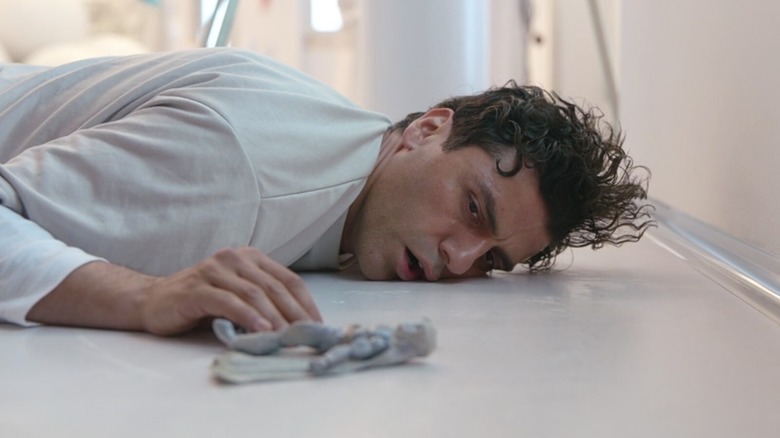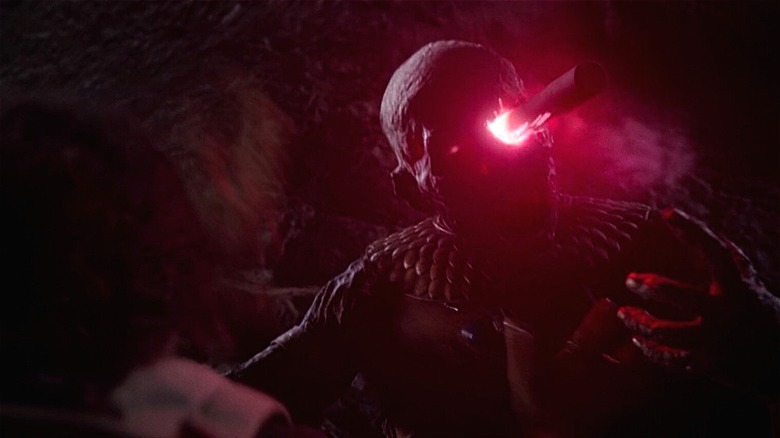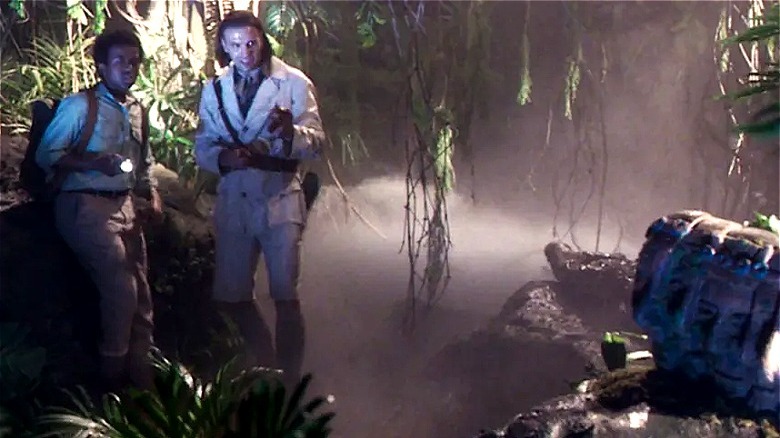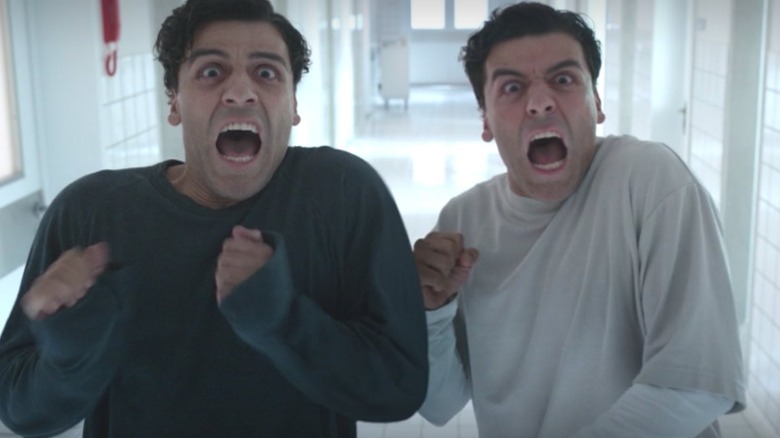Moon Knight Just Went Full Benson And Moorhead, And Marvel Has Never Been Wilder
Warning: Major spoilers ahead for episode 4 of "Moon Knight."
Episode 4 of "Moon Knight," titled "The Tomb," is perhaps the trippiest, most mind-boggling episode so far, proving that episode 4 directors Justin Benson and Aaron Moorhead are perfect for helming the most outlandish sequences.
Primarily, "The Tomb" is a full-fledged puzzle-solving archeological adventure with Steven (Oscar Isaac) and Layla (May Calamawy) at the center, although the final 15-20 minutes of the episodes veer into intense fever dream territory (which warrants at least one proclamation of "what the hell is going on?" out loud). Being a Marvel show, "Moon Knight" has been pushing against the mold of a superhero origin story since episode 1 dropped, and it continues to defy expectations by upping the wild factor, which culminates in the frenetic, delightful spectacle that is episode 4.
Never have I ever grappled with a Heka priest
The moment Steven and Layla set foot near Dr. Arthur Harrow's (Ethan Hawke) archeological dig site, something feels tremendously off. Given Harrow's obsessive nature (and the fact that his men tailed Marc and Layla across Cairo), the fact that the dig site was abandoned and had absolutely no one around to apprehend the duo spelled danger from the get-go.
Benson and Moorhead frame these sequences with great skill (obviously), dropping hints for the horrors that lie ahead in the form of a quick shot of fresh blood spilled inside a tent, along with a blood-smeared ancient weapon of sorts. The filmmaking duo is no stranger to depicting entities (including invisible ones, such as in their 2017 film "The Endless"), and the fact that an ancient tomb housing a demoness might be crawling with undead threats further adds to the anticipation.
Steven and Layla (and an utterly seething Marc, who is only able to communicate via Steven's reflection) venture inside the ancient tomb, replete with an intricate maze, marbled sphinxes, and the like. The atmosphere inside is understandably tense, as Layla and Steven are wildly underprepared for anything unsavory they might encounter around the corner, while Harrow's men can be heard shooting at something in the distance. While the puzzle-solving and Egyptian mythology deep dive is entertaining, things get sinister real fast when they see fresh blood smears, littered bones, and recently-filled canopic jars near a stone slab (there's even a shot of Steven finding snakeskin grafted into the shape of ... a hand).
Of course, the thing(s) Harrow's men were shooting at were Heka priests, who are undead guardians meant to protect the pharaoh's chamber from unwanted intruders. The design of the humanoid Heka priests is positively terrifying: they look grimy and make an ominous clicking sound that reverberates across the tomb, and they are decked in ceremonial uniforms and sharp murder weapons, taking no time to rip out intestines and harvest them at breakneck speed. These sequences harken back to Benson and Moorhead's creature features, especially "Spring" and "After Midnight," wherein the former featured various mutant monsters of the slimy variety. The result is terrifying, action-packed mummy horror that branches into something MORE bonkers.
Move aside Indiana Jones, it's time for Tomb Buster
After Marc is shot by Harrow inside Alexander the Great's tomb, he falls backward into a pool of water, and this is when the phantasmagoric shift in the episode begins. Suddenly, we are inside a stark, pristine white facility, where Marc is seen in a wheelchair, heavily sedated, clutching a "Moon Knight" action figure. Before you can yell what-in-the-meta-twist-reveal-is-this, the visual cues in the scene constantly feed information that directly challenges whatever we have experienced so far. There's Layla, Crowley, and Donna inside the Putnam Psychiatric Ward, alongside other members, playing bingo, a rough drawing of a pigeon-like figure (Khonshu), a cupcake stand, a painting of the Alpine village, and so on.
Benson and Moorhead, throughout their filmography, have always posited that visual evidence holds more weight than personal experiences of an event, epitomized in their sci-fi horror flick "The Endless." In the film, Justin and Aaron's memories about Camp Arcadia are molded and informed by their individual worldviews, but the dire reality of the visual cues and actual cues proves the existence of a ruthless, primordial entity roaming the grounds of the camp.
In "Moon Knight," this same sensibility is instilled but questioned: while Marc's surroundings provide visual evidence that the events might be a result of a trauma-induced psychotic break, it is Marc and Steven's unified personal experiences with Harrow that affirm that this might just be a psychological limbo forged to entrap them. While this mental institution storyline has been directly lifted from the "Moon Knight" comics, the results are still shocking, as the directors add their own unique flair to the events that unfold.
The inclusion of the fake movie, "Tomb Buster," which follows an "Indiana Jones"-esque adventure with a certain Dr. Steven Grant, works remarkably well within the scope of the story. Of course, Hawke as a mustached Dr. Arthur Harrow, who attempts to calm Marc down by explaining that he is mentally ill, only adds to the sheer terror and disorientation of the scene (which is exactly how Marc feels at that moment).
Even you would scream during a talking-hippo encounter
Now, Marvel dives into the fantasy realm in its franchise offerings — there are alternate timelines, the opening of the multiverse, time travel, and galactic entities of varying kinds (while some are full-fledged gods). However, what makes episode 4 of "Moon Knight" so refreshingly weird is the melding of grounded and outlandish storylines, executed via compelling characters with rich inner worlds. While there is a supernatural element inherent within a show about an avatar of an Egyptian god, the psychological aspects of "Moon Knight" are layered and grounded in reality, while also sprouting a surreal, symbolically-dense arm to help elevate the story.
After Marc is terrified by the absurdity of his surroundings, he attempts to escape the facility while evading the orderlies who work there. Locking himself inside a room, he sees a sarcophagus, inside which, someone is trapped within, screaming for help. On lifting the lid, Marc is relieved to find out that it is Steven, and the two automatically hug (a sweet, pivotal moment). The duo attempt to escape together, but encounter a hippo decked in ceremonial costume, who squeals a sweet "hi!" at the baffled duo. They scream (no matter how cute she seems to be, it is terrifying). Turns out that the hippo in question is the Egyptian goddess Taweret, who was previously teased as a museum soft toy in episode 1.
Yes, the ending reveal is absolutely wild and offers no immediate answers, but definitely sets the tone for the wild, eventful ride we are in for in the upcoming episodes. No one knows what's real, major character fates hang in the air, and more mysteries lurk in the shadows. This episode of "Moon Knight" really went full Benson and Moorhead, which is always a wonderful thing, and the duo delivered in the best possible way.
Episodes 1 through 4 of "Moon Knight" are currently streaming on Disney+.



